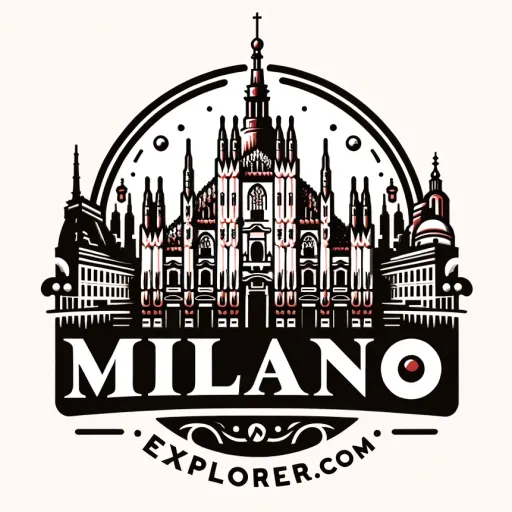If you’re visiting Milan and want to shop for organic clothing, you’re in for a treat. Milan, one of the world’s fashion capitals, offers a wide range of options for those seeking eco-friendly and sustainable fashion. You can find a variety of stores that specialize in organic clothes, ensuring you not only look good but also feel good about your purchases. From chic boutiques to well-known sustainable brands, Milan has something for every eco-conscious shopper.
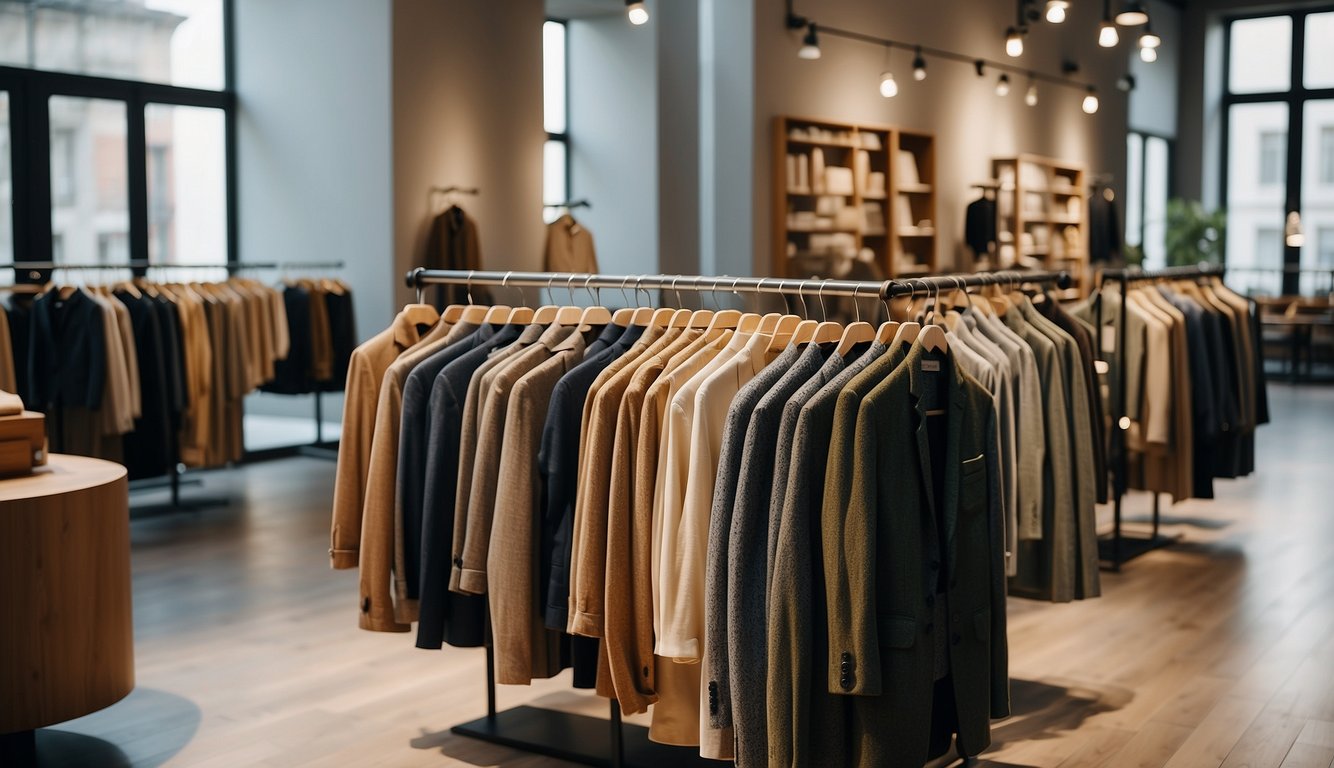
One notable spot to explore is BIVIO, a beloved second-hand store in Milan. Here you can discover vintage and second-hand clothing that supports sustainable fashion practices. The store is a perfect blend of style, affordability, and eco-friendliness, making it a must-visit for fashion enthusiasts who care about the planet.
For those interested in brands committed to ethical and sustainable fashion, Candiani stands out. Operating since 1938, Candiani offers a range of textiles and clothing made from eco-friendly materials such as organic cotton and recycled leather. This commitment to quality and sustainability makes Candiani a favorite among Milan’s eco-conscious shoppers.
Organic Clothes in Milan
Key Takeaways
- Milan offers numerous options for eco-friendly and organic clothing.
- Visit BIVIO for stylish and affordable second-hand fashion.
- Candiani’s sustainable textiles and clothing are a top choice for ethical shopping.
Understanding Sustainable Fashion
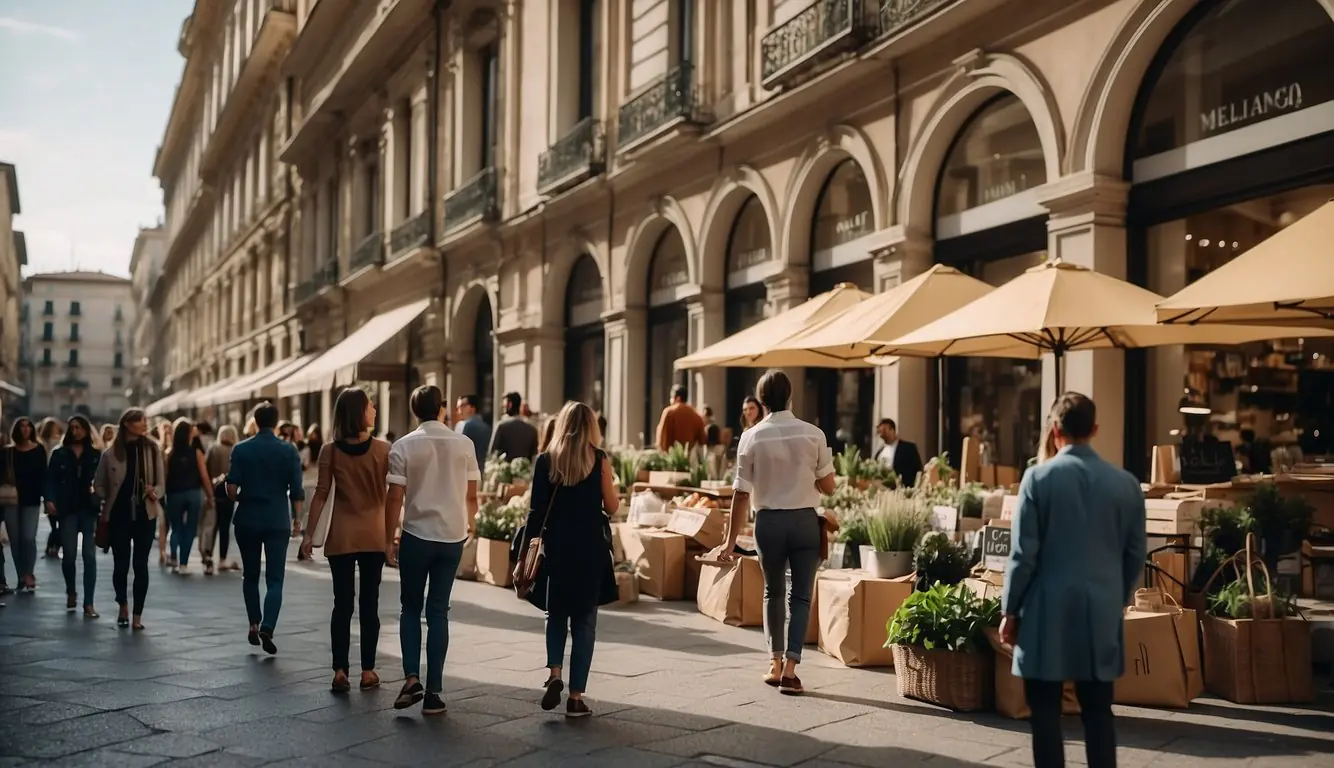
Sustainable fashion integrates eco-friendly materials and ethical practices to create garments with a reduced environmental impact. We’ll look at what defines eco-friendly clothing and the importance of ethical practices for workers.
Defining Eco-Friendly Apparel
Eco-friendly apparel focuses on materials and production methods that are less harmful to the environment. It often includes fabrics such as organic cotton, recycled polyester, hemp, and bamboo. These materials have lower environmental footprints compared to traditional fabrics like conventional cotton or synthetics made from petroleum.
Sustainable production methods are just as critical. This means using less water, fewer chemicals, and less energy. Many brands aim to reduce their carbon emissions and work towards zero waste by recycling or repurposing scraps. Transparency is key; providing customers with information about the sourcing and manufacturing of products helps them make informed choices.
The Impact of Ethical Practices on Workers
Ethical practices ensure that those who make our clothes work under fair conditions. This includes providing a living wage, safe working environments, and reasonable working hours. Ensuring that workers’ rights are respected helps combat exploitation and poor labor conditions often seen in the fashion industry.
Brands committed to ethical practices also focus on fair trade. This guarantees that workers receive fair compensation for their labor. Furthermore, ethical fashion encourages community development by investing in local economies and supporting small-scale manufacturers.
Prioritizing workers’ well-being and fair wages is crucial for sustainable fashion. It leads to better quality garments and helps build a responsible and humane industry.
Major Fashion Capitals Embracing Sustainability
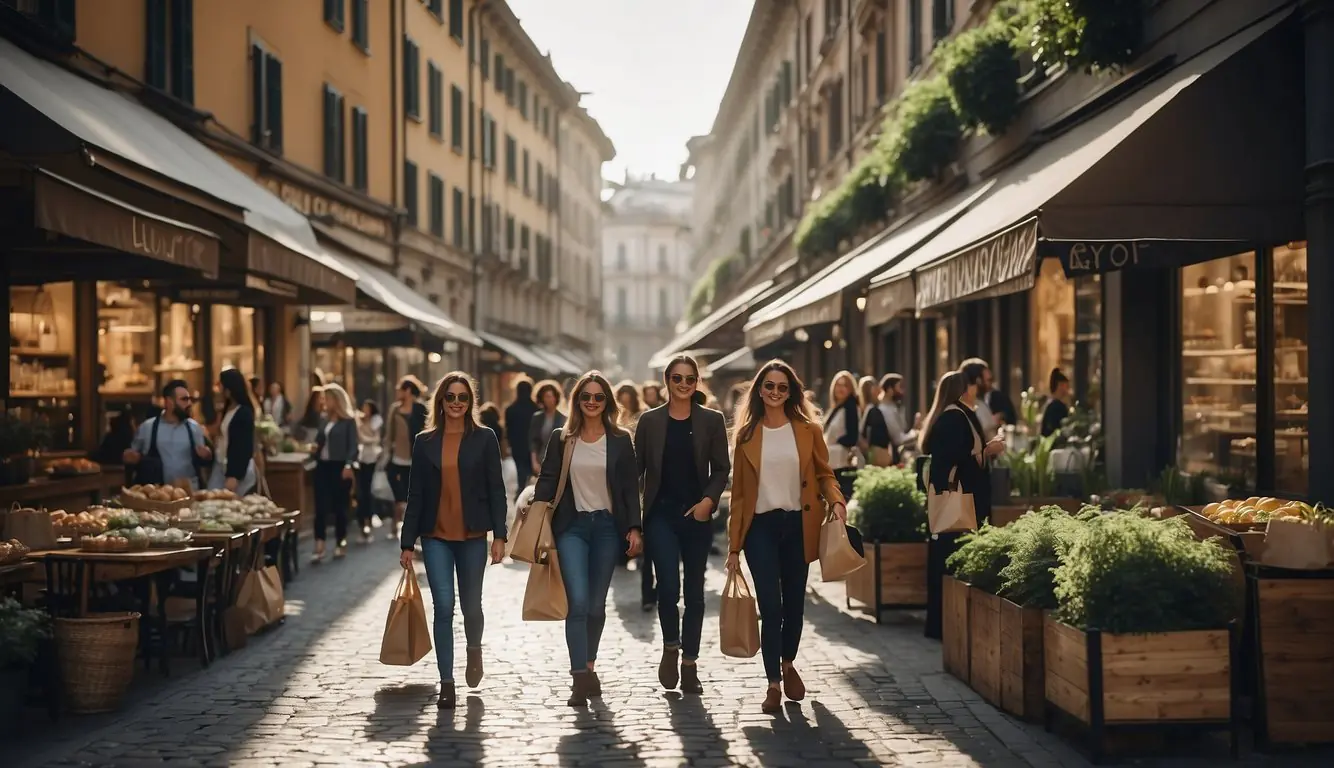
Sustainable fashion is gaining momentum in some of the world’s most renowned fashion capitals. Two cities at the forefront of this movement are Milan and Paris, each playing a significant role in promoting eco-friendly practices in the fashion industry.
Milan: A Front-Runner in Ethical Fashion
Milan, known for its luxury and high-fashion labels, is home to various sustainable clothing brands. For instance, brands like Bottega Veneta focus on designing eco-friendly womenswear, menswear, shoes, handbags, and accessories. Their dedication to sustainability extends to creating fragrances and jewelry, ensuring a reduced environmental footprint. You can find more on sustainable fashion brands like Bottega Veneta through various fashion blogs that highlight their efforts.
Additionally, Milan offers a variety of second-hand and vintage shops. BIVIO stands out as a beloved spot for eco-conscious shoppers looking for a mix of modern and vintage styles. Shopping at local second-hand stores not only promotes recycling but also helps in making fashion more accessible and affordable. Check out BIVIO to explore their collections.
The Role of Paris in Promoting Eco-Fashion
Paris, another iconic fashion hub, has taken significant strides towards sustainability. The city hosts numerous ethical fashion labels that emphasize eco-friendly and fair-trade practices. Many Parisian designers are now focusing on organic fabrics, zero-waste patterns, and eco-friendly dyes.
Paris Fashion Week has also become a platform for showcasing sustainable collections, encouraging other designers and brands to adopt greener practices. Events and exhibitions dedicated to sustainable fashion are frequently held, reflecting the city’s commitment to the cause.
Additionally, several Paris-based brands have switched to using recycled materials, further reducing their environmental impact. These efforts position Paris not just as a fashion leader but also as a pioneer in eco-conscious design and production.
By embracing these sustainable practices, Milan and Paris set a powerful example for other fashion capitals worldwide.
Sustainable Fabrics and Materials

When it comes to sustainable fashion, the choice of materials is critical. From organic cotton to recycled materials, and even vegan and natural alternatives, there’s a wide range of options that promote environmental responsibility.
From Organic Cotton to Recycled Materials
Organic cotton is one of the most popular sustainable fabrics. Unlike traditional cotton, it is grown without synthetic pesticides or fertilizers, making it safer for both the planet and the people who produce it. Brands like Candiani use organic cotton extensively in their collections.
Recycled materials are another important component in sustainable fashion. These include recycled cotton, polyester, and other fabrics made from post-consumer waste, such as plastic bottles. This approach reduces the need for new raw materials and minimizes waste. For instance, Versace incorporates recycled plastic into its high-end designs.
The Emergence of Vegan and Natural Alternatives
Vegan fabrics are increasingly becoming a mainstay in eco-friendly fashion. These materials avoid any animal products, catering to both ethical and environmental considerations. Examples include Piñatex, made from pineapple leaves, and TENCEL™, derived from sustainably sourced wood pulp. These fabrics are not only cruelty-free but also highly sustainable, offering a win-win for conscious consumers.
Natural materials like hemp and linen also play a crucial role. Hemp, for instance, requires very little water and no pesticides to grow, making it an excellent choice for sustainable clothing. Linen, made from the flax plant, is another durable and eco-friendly option that many brands are now embracing.
These materials are helping to shape a more sustainable and responsible fashion industry. For more detailed information on sustainable fabrics, check out this ultimate guide.
Influential Sustainable Brands and Designers
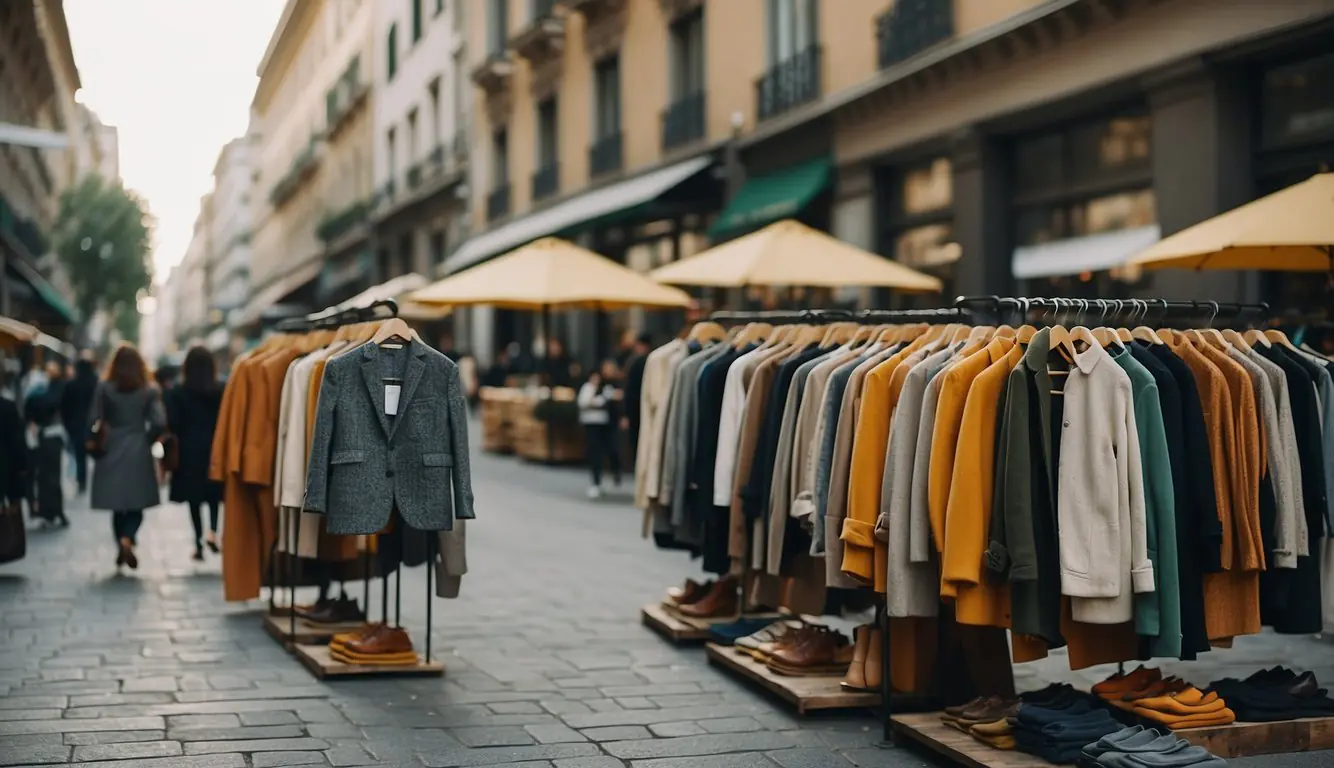
In Milan, finding sustainable fashion doesn’t mean compromising on style or luxury. Many influential Italian brands are making significant efforts towards sustainability, ensuring both high quality and ethical practices in their designs.
Leading Italian Brands in Sustainability
One of the key players in sustainable fashion in Milan is Candiani. Founded in 1938, Candiani has become a leader in sustainable denim production. They are well-known for using water-saving technologies and reducing chemical consumption in their processes. Although they don’t sell directly to consumers, they supply denim fabrics to numerous fashion brands, making a substantial impact on the industry.
Another notable brand is Bottega Veneta, founded in 1966 by Michele Taddei and Renzo Zengiaro. Known for their eco-friendly womenswear, menswear, shoes, handbags, and accessories, Bottega Veneta continues to be a pioneer in luxury sustainable fashion. They integrate sustainability into their designs without sacrificing luxury or quality.
Versace and Armani, although traditionally recognized for luxury and style, are also beginning to embrace more sustainable practices. Their commitment includes using eco-friendly materials and implementing more ethical production processes. This shift reflects the broader movement toward sustainability within the fashion industry.
Exploring Luxury Labels With Ethical Commitments
Gucci and Prada are iconic names in the fashion world, renowned for their luxurious designs. Recently, both brands have made strides in incorporating sustainability into their collections. Gucci has focused on reducing its environmental footprint through sustainable sourcing and innovative production methods. Similarly, Prada launched the Re-Nylon collection, using recycled materials to create high-quality, luxury items.
Jil Sander and Dolce & Gabbana also stand out in the sustainable fashion landscape. Jil Sander emphasizes minimalistic yet elegant designs, crafted with sustainable materials. Dolce & Gabbana, known for their vibrant and opulent fashion, has started focusing more on ethical practices and eco-friendly fabrics.
These brands illustrate how the marriage of luxury and sustainability can lead to innovative, stylish, and ethically sound fashion. The commitment shown by these influential designers signifies a promising direction for the future of fashion in Milan.
Consumers and Sustainable Shopping Habits
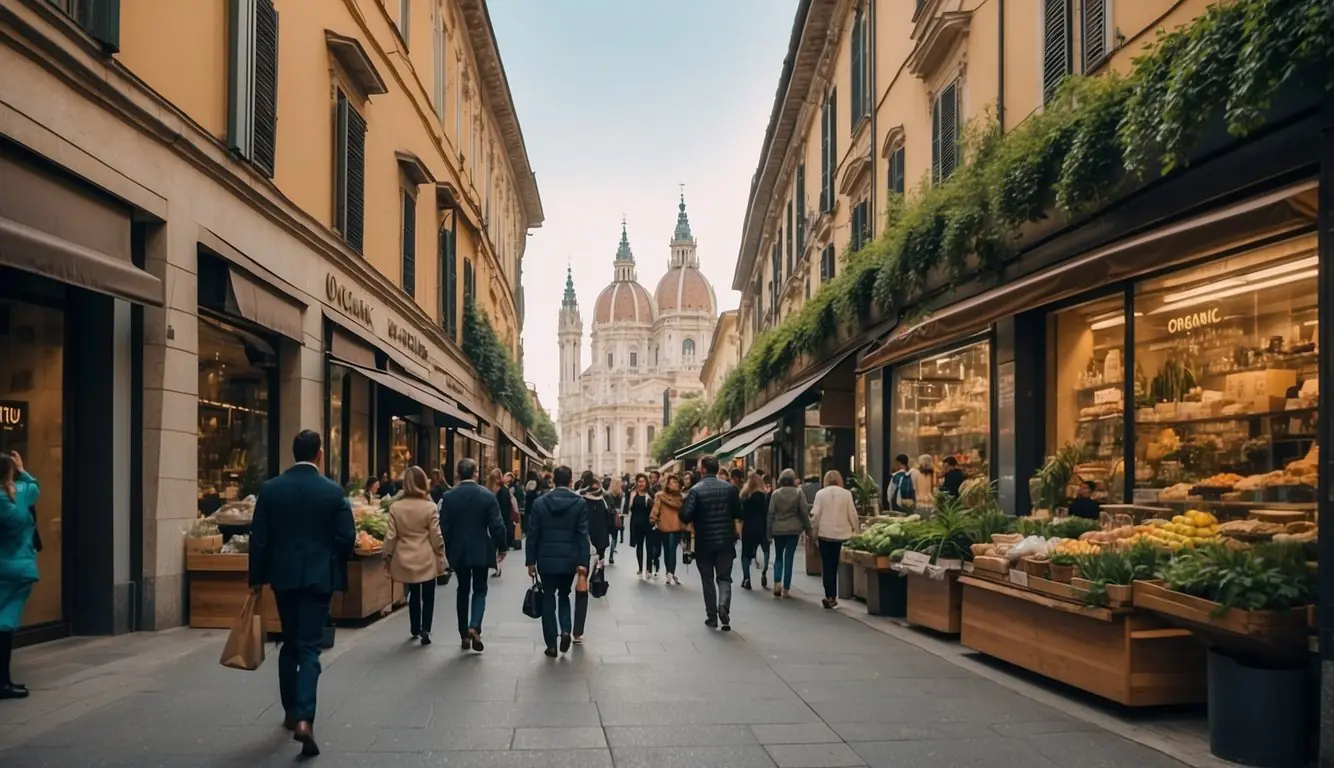
In Milan, shoppers are increasingly embracing sustainable practices, from investing in high-quality vintage clothing to adopting a circular economy mindset in their wardrobe choices.
Adopting a Circular Economy in Wardrobe Choices
Many of us in Milan are turning to the concept of a circular economy in our fashion choices. This means buying fewer, better-quality pieces that last longer, and recognizing the value in second-hand shopping. By choosing sustainable brands and recycled materials, we minimize waste and reduce our environmental footprint. Milan’s fashion scene offers plenty of options for this, as highlighted by Bottega Veneta’s eco-friendly collections.
In addition to buying new sustainable pieces, we can participate by donating or selling our gently used clothes. This keeps textiles in use and out of landfills. Many local shops and online platforms make it easy to contribute to a more sustainable fashion ecosystem.
The Appeal of Vintage Clothing and High-End Resale
Vintage shopping continues to gain popularity in Milan. By choosing vintage clothing, we not only add unique items to our wardrobes but also support a more sustainable fashion industry. Vintage shops and resale boutiques, such as BIVIO, offer a range of stylish and eco-friendly options for consumers who want to make mindful choices.
High-end resale is also a thriving market. We can find luxury items from top brands like Versace and Armani at more affordable prices. This appeals to many fashion enthusiasts who want to invest in quality without the environmental cost of new production. Milan’s array of vintage and second-hand boutiques makes it easy to discover hidden gems and elevate our personal style sustainably.
Fashion Throughout the Seasons
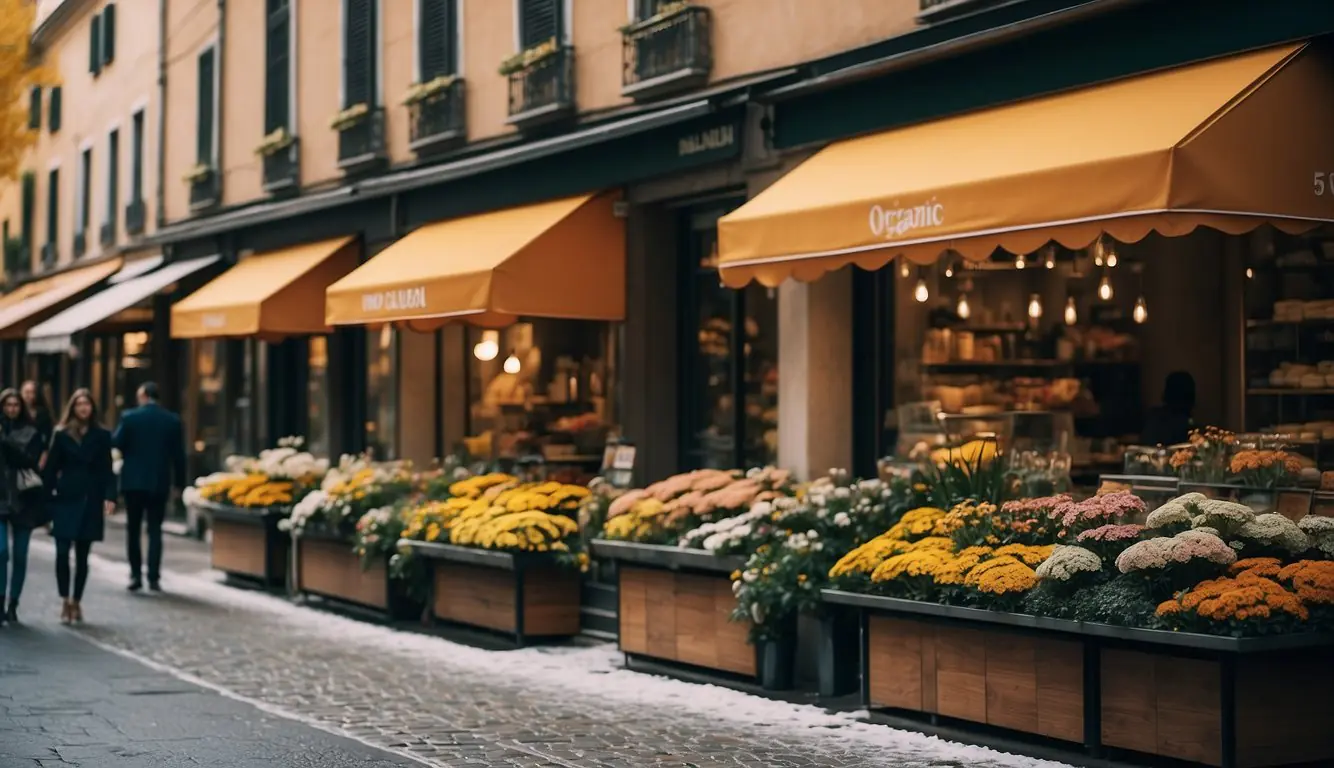
When shopping for organic clothes in Milan, it’s important to consider how to dress sustainably throughout the different seasons. We will focus on creating a versatile wardrobe that adapts to summer and spring while promoting responsible consumerism.
Curating a Sustainable Summer Wardrobe
For the hot Milanese summer, we should choose lightweight fabrics such as organic cotton and linen. These materials are breathable and comfortable in high temperatures.
Sun protection is crucial, so wide-brimmed hats, sunglasses, and light scarves are essential. Dresses and shorts are popular for their simplicity and comfort. One of Milan’s standout sustainable brands is Bottega Veneta, known for eco-friendly women’s and men’s apparel.
Layering can also be helpful for transitioning from hot afternoons to cooler evenings. A light cardigan or shawl in organic fibers can add versatility without compromising on sustainability.
Transitional Fashion for Spring and Responsible Consumerism
Spring in Milan features variable weather, so layering is vital. Start with basics like organic cotton tees and blouses, then add sweaters or light jackets that can be easily removed.
Neutral colors such as beige, white, and soft pastels are perfect for a spring palette. They can mix and match easily, reducing the need for excessive purchases and supporting responsible consumer habits.
We recommend pieces from local brands that emphasize sustainability. BIVIO offers a range of second-hand and vintage options, helping us stay trendy and eco-friendly. Shopping second-hand not only supports the environment but also adds unique fashion pieces to our wardrobe.
Shopping Destinations and Experiences
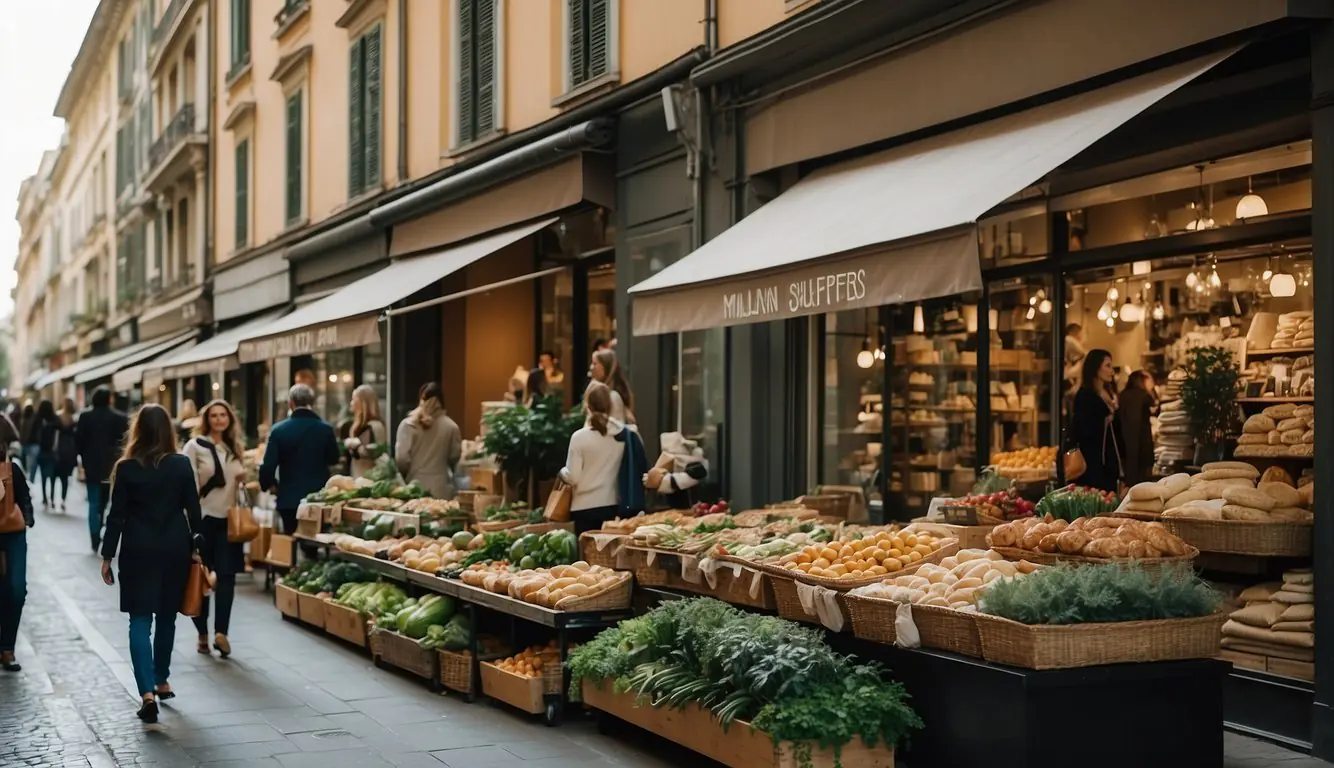
In Milan, buying organic clothes is an exciting journey through both iconic fashion spots and unique boutiques offering sustainable and stylish options. There are many places where we can find high-quality organic clothing and thoughtful gifts.
Iconic Locations and Stores in Milan’s Fashion Scene
Milan boasts some of the most iconic fashion locations. The Quadrilatero della Moda is famous for its luxurious atmosphere. Here, we find high-end designer boutiques and major luxury labels that offer eco-friendly collections.
Another landmark is Corso Como,10 Corso Como, where contemporary fashion and art meet. This area is a hub for sustainable fashion.
For a more traditional shopping experience, La Rinascente near Piazza del Duomo provides a vast range of organic fashion brands. This department store offers multiple floors of eco-conscious choices.
Finding Unique Souvenirs and Gifts With a Sustainable Focus
For those looking for unique, sustainable souvenirs and gifts, Milan offers plenty of options. Navigli is an excellent area to start, known for its beautiful canals and quaint shops.
Stores like Humana Vintage and Bivio provide second-hand and vintage clothing, allowing us to shop sustainably while also finding unique pieces.
For more high-end choices, Antonioli offers an exclusive selection of designer items with eco-friendly fabrics.
Don’t forget to check for VAT refunds on purchases, which can make buying organic clothes even more rewarding. Shopping in Milan combines the excitement of finding trendy, eco-friendly fashion with the joy of discovering memorable gifts for loved ones.
The Global Context of Sustainable Fashion

Sustainable fashion is shaping the future of the clothing industry by integrating eco-friendly materials and ethical practices. Understanding how different regions contribute to this movement can help us appreciate the global efforts behind sustainable fashion.
How India Contributes to the Sustainable Fabric Industry
India plays a pivotal role in the sustainable fashion sector. Known for its certified organic cotton production, India supplies significant amounts of eco-friendly fabric to the global market.
In regions like Gujarat and Maharashtra, local farmers use traditional farming techniques that avoid synthetic pesticides and fertilizers. This not only preserves soil health but also protects farmers from harmful chemicals.
Indian artisans are renowned for their craftsmanship, producing beautiful, handwoven textiles. These fabrics are not only sustainable but also support local economies by providing jobs and preserving cultural heritage.
Platforms like Good On You highlight brands that rely on India’s sustainable fabric industry, ensuring fair wages and safe working conditions. This highlights the importance of India’s role in advancing global sustainable fashion.
The Significance of Local Producers and Craftsmanship
Supporting local producers is essential for the sustainable fashion movement. By purchasing locally made products, we reduce the carbon footprint associated with long-distance shipping. Local artisans often create high-quality, durable items that last longer, promoting a culture of sustainability.
In Milan, for example, several brands emphasize local craftsmanship. Brands such as Bottega Veneta incorporate traditional techniques into their modern designs, creating luxury items that are also eco-friendly.
Craftsmanship also means supporting local economies. By valuing and purchasing handmade items, we help sustain communities and keep traditional skills alive. This practice is a cornerstone of the global sustainable fashion industry, celebrated in cities like Milan and beyond.
By understanding these aspects, we can better appreciate the interconnected efforts that make fashion sustainable worldwide.
Addressing Challenges in the Industry
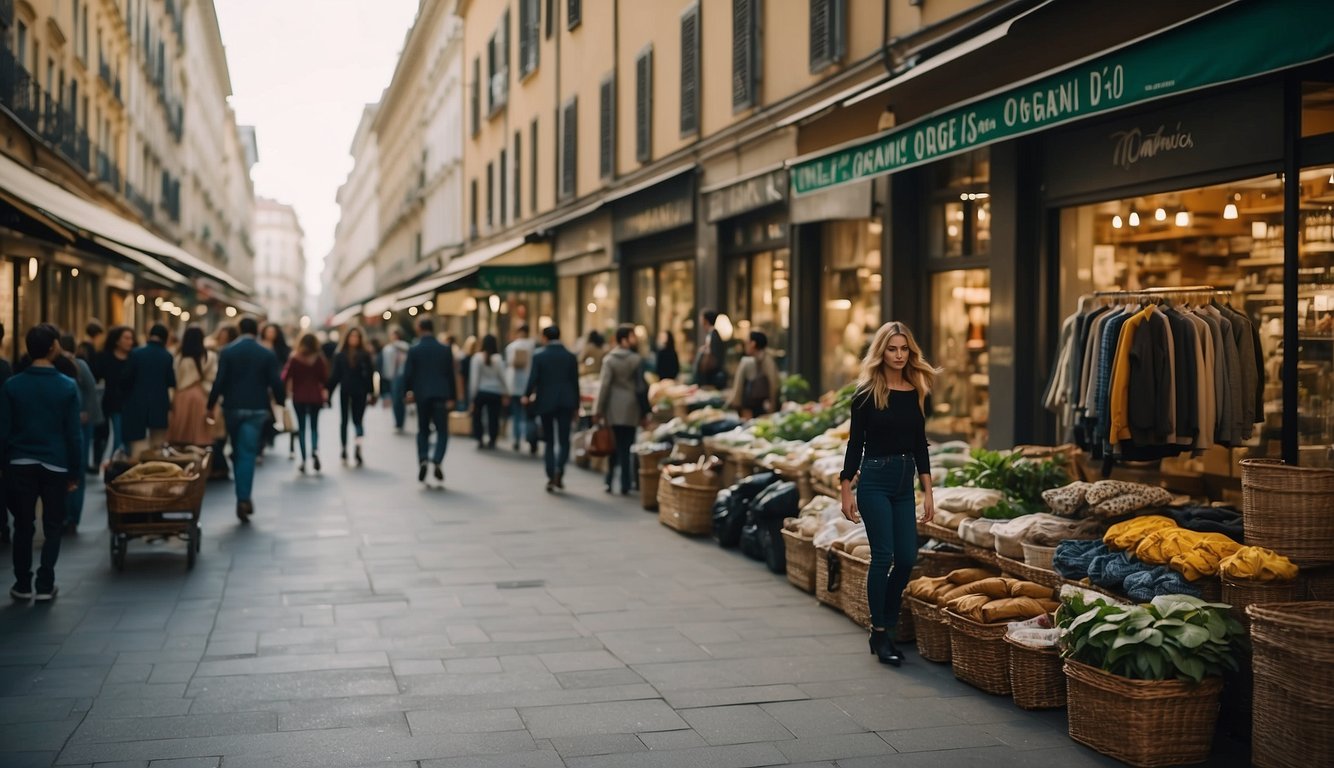
In the organic clothing industry, there are significant challenges related to balancing resources, energy, and sustainable growth, as well as advancements in eco-friendly dyes and fertilizers. These issues are crucial for building a more responsible and eco-conscious fashion sector.
Balancing Resources, Energy, and Sustainable Growth
Balancing resources and energy for sustainable growth is one of the biggest hurdles. Producing organic fabric requires more land compared to conventional farming, due to lower crop yields. This increased land use can strain valuable land resources, making it difficult to maintain a balance.
Additionally, organic farming often demands more manual labor, raising production costs. The higher prices for sustainable clothing can deter some consumers, limiting the market’s growth. On the energy front, transitioning to renewable energy sources for manufacturing can be expensive and complex.
Moreover, the logistical challenge of transporting organic materials while minimizing carbon footprints adds to the complexity. Using local resources and clean energy should be prioritized to mitigate these issues.
Developments in Eco-Friendly Dyes and Fertilizers
The development of eco-friendly dyes and fertilizers is essential to reducing the environmental impact of organic clothing production. Traditional dyes often contain harmful chemicals, but new natural dyes made from plants and minerals are much safer for the environment and workers.
These dyes, however, can be less colorfast and more expensive. To combat these downsides, ongoing research is essential to improve their durability and reduce costs without compromising their eco-friendly nature.
Similarly, using natural fertilizers like compost and manure is better for the soil but can be less efficient than synthetic options. Innovations in organic fertilizer formulations aim to increase their effectiveness, making them more viable for widespread use.
By supporting these advancements, we can push the industry towards more responsible and sustainable practices.
Conclusion
When it comes to sustainable and ethical fashion in Milan, there are several standout choices. Shopping for organic clothes is not just a trend; it’s a commitment to a better future.
Candiani is a great place to start. They offer a range of clothes made from organic cotton, recycled leather, and TENCEL™. Their dedication to sustainability dates back to 1938. You can check out their collections here.
Another option is BIVIO, a beloved second-hand and vintage shop. Here we can find unique pieces that are both stylish and good for the environment. This store makes it easy to look great and shop sustainably. More details can be found on this site.
Those looking for luxury should consider Bottega Veneta, which offers eco-friendly womenswear, menswear, shoes, and accessories. Founded in 1966, the brand continues to spearhead the move toward sustainable luxury fashion. Learn more about them here.
Milan’s independent fashion scene also contributes significantly to the sustainable fashion movement. Designers focus on harmony and beauty through ethical practices, shaping a future of fashion that we can all feel good about. To discover more about these creative minds, visit this article.
Let’s continue to support these incredible brands and make a positive impact with our purchases. Sustainable fashion is not just a choice but a responsibility we all share.
Frequently Asked Questions
Milan is home to many places where we can find organic and sustainable clothing. From high-end designer stores to affordable second-hand shops, there’s something for every budget and style in this fashion capital.
Where can I find sustainable womenswear in Milan?
For sustainable womenswear, we recommend visiting Bottega Veneta. They offer eco-friendly designs and high-quality fabrics. Another great option is Vesti La Natura, where you can find a variety of organic dresses and t-shirts.
What are the best shops for organic menswear in Milan?
When it comes to organic menswear, Bottega Veneta also has a solid collection. They offer stylish and eco-conscious options that are worth checking out. Additionally, many boutiques in Milan’s fashion districts offer a range of organic options for men.
Where can I buy affordable eco-friendly clothing in Milan?
For those looking for budget-friendly options, BIVIO is one of the best spots in Milan. This store offers a wide range of second-hand and sustainable fashion. You can find quality pieces without breaking the bank.
Which Milanese clothing stores offer the best selection of organic apparel?
For a broad selection of organic apparel, Vesti La Natura is a great choice. They focus on organic clothing and offer a variety of items at different price points. Another store worth exploring is Panaprium for its extensive range of eco-friendly garments.
How do I locate stores that sell organic fashion brands in Milan?
To find stores selling organic fashion brands, we suggest exploring well-known districts like Quadrilatero della Moda and Brera. These areas are filled with boutiques and showrooms. Using online guides like MilanoExplorer can also help pinpoint specific locations.
Are there any famous eco-conscious designer stores in Milan for high-quality garments?
Yes, Milan houses several renowned designers focused on sustainability. For example, Bottega Veneta is celebrated for its high-quality, eco-friendly fashion. These stores not only offer luxury but also ensure their products are environmentally responsible.
